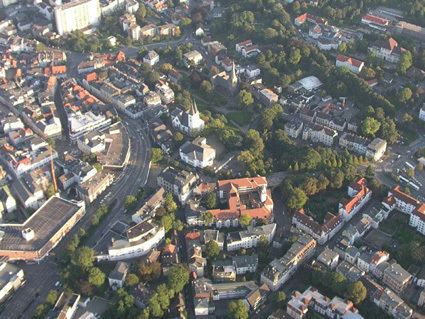Country Germany Admin. region Arnsberg Elevation 494 m (1,621 ft) Area 125.5 km² Local time Thursday 12:44 AM | Time zone CET/CEST (UTC+1/+2) Population 95,179 (30 Jun 2010) | |
 | ||
Weather 4°C, Wind SW at 5 km/h, 83% Humidity Colleges and Universities South Westphalia University of Applied Sciences, Business and Information Technology School | ||
Iserlohn ( [iːzɐˈloːn]) is a city in the Märkischer Kreis district, in North Rhine-Westphalia, Germany. It is the largest city by population and area within the district and the Sauerland region.
Contents
- Map of Iserlohn Germany
- Geography
- History
- Points of interest
- Sports
- Education
- Schtzenfest
- Coat of arms
- International relations
- Sons and daughters of the town
- References
Map of Iserlohn, Germany
Geography
Iserlohn is located at the north end of the Sauerland near the Ruhr river.
History
The Pancratius church (also called Bauernkirche) was founded in around 985, but the first written document mentioning lon dates only from 1150. In 1237 the Count of the Mark gave Iserlohn municipal rights. In 1975 the city, which had been an urban district before, incorporated the surrounding ex-municipalities of Letmathe, Hennen, Sümmern and Kesbern, and became part of the district "Märkischer Kreis". As a larger mid-sized city, Iserlohn, however, still has a special status as compared to most other municipalities in the district. This means that the city takes on tasks more usually performed by the district (e.g. social and youth affairs) so that in some ways it is comparable to an urban district.
Points of interest
The Dechenhöhle was discovered in 1868 during the construction of the railway line Hagen-Iserlohn. 360m are accessible for visitors, and lots of stalactites make it a spectacular sight.
The Danzturm, located atop the southern hill overlooking the old city, is a landmark and featured on the logo of the local brewery (Iserlohner). The tower features spectacular views of the valley and surrounding hills and is open to the public with a small inn at the base.
In the 18th Century, the town became known for its Iserlohn boxes, a form of tobacco or snuff box with an engraved or embossed lid that often featured an image of Frederick the Great.
Sports
The city is home of the Iserlohn Roosters, a DEL (first-division) ice hockey team. They came into the DEL in 2000 and developed from a low-budget-team to a solid team, which battles every year for a Playoff-spot. The club plays its homegames at the Eissporthalle Iserlohn, which holds 4967 spectators. The original club EC Deilinghofen was founded in 1959 and went bankrupt in 1987, the second club ECD Sauerland existed from 1988 to 1994. 1994 the Iserlohner EC was founded whereof the Roosters came to the DEL.
Education
In Iserlohn are 15 elementary schools and 13 secondary schools (4 Gymnasien, 1 Gesamtschule, 3 Realschulen, 5 Hauptschulen).
Also two universities of applied sciences are located in the city of Iserlohn. The headquarters plus a major branch of the South Westphalian University of Applied Sciences (also: Fachhochschule Südwestfalen (FH SWF)) offering engineering and informatics programmes are located in the town centre and on the so-called Alexanderhöhe. The Business and Information Technology School (BiTS) is a private state approved business school with a campus near the Seilersee.
Schützenfest
Every year a part of the Iserlohner culture is the Schützenfest at Alexanderhöhe with its Parkhalle and the Friedensfest at Bauernkirche.
Coat of arms
In the middle of the coat of arms is Saint Pancras (St. Pancratius), patron of the oldest church in Iserlohn. He is depicted between two towers of the historic city wall. The checked fess below is derived from the arms of the Counts of the Mark.
International relations
Iserlohn is twinned with:
